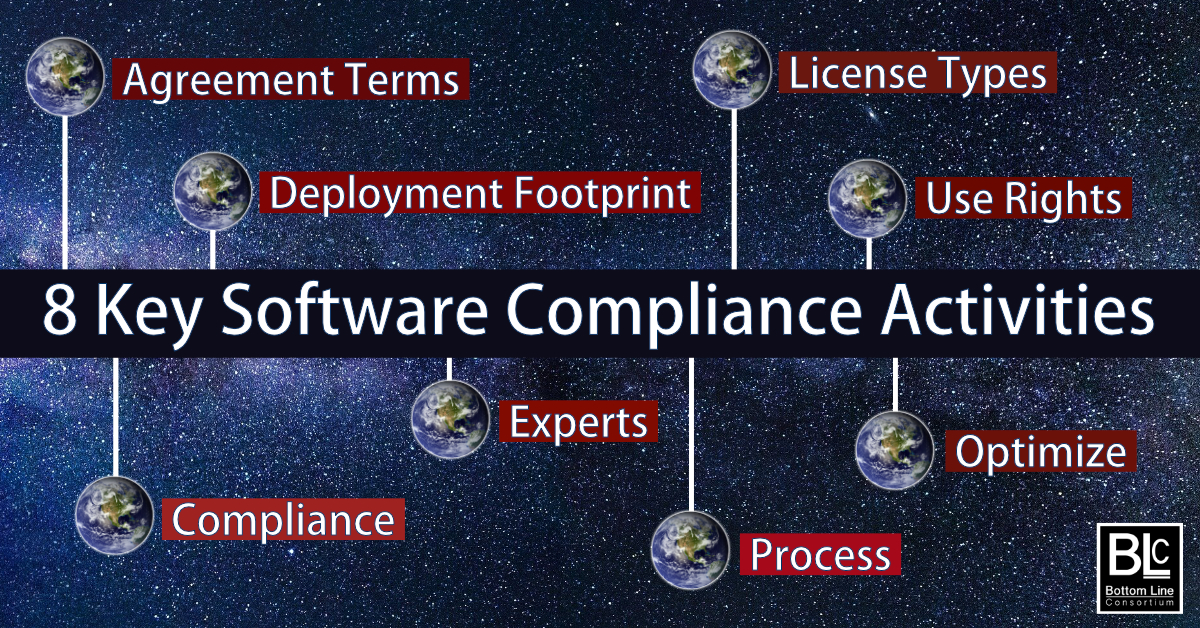1. Be very clear about the vendor agreement terms and penalties
- Gather all signed agreements
- Review language for each product along with all associated agreements
- Understand compliance audit rights and procedures
- Be clear about the remedy and cost of compliance resolution
- Work with vendor to consolidate agreements where advantageous
- Identify any auto-renewal or other triggered contract language
- Review cancellation language
- Research any related agreement language on the vendor website
2. Determine the type and quantity of licenses you own
- Gather all software purchase history
- Be clear on upgrade rights and path
- Look for rights that might have been forfeited or transferred
- Be aware of any geographic restrictions
- Know when and where the purchase was finalized
- Review budget and purchase justification documentation
3. Know your software deployment footprint
- Map all equipment and software using discovery and inventory tools
- Remove decommissioned equipment and software from CMDB
- Complete a consolidated and reconciled Enterprise License Position (ELP)
- Analyze deployment patterns including upgrades and adoption patterns
- Examine active and planned technology implementations to assess licensing needs
- Explore technology utilization metrics
- Understand configuration standards and governance
- Identify cross-platform licensing implications
- Review cross-geography deployment
- Analyze support, incident logs and maintenance history
- Interview key stakeholders to understand implementation choices
4. Understand your product use rights and risk
- Map critical terms from all active agreements
- Look closely at shared, hosted, or virtualized environments
- Pay extra attention to mobility rights
- Be clear about upgrade rights for each implementation
- Review change history for each environment
- Know how acquisitions, divestitures, consolidations, and company growth impact rights
- Understand vendor product strategies hidden in the agreements that are incompatible with your needs
- Review situations triggering purchases, license cancellations, auto-renewals, or audits
- Be aware that license rules are often intentionally unclear and could change without notice
- Review governance guidelines and consistency
5. Engage experts to assist as required
- Complexity requires expert focus and deep understanding of licensing and strategic alternatives
- Well-intentioned technicians make choices without knowing licensing pitfalls causing risk
- Experience with ever-changing conditions facilitates optimization
- Experts use proprietary and industry tools for detailed analysis
6. Optimize license allocation
- Know your detailed software footprint and ELP
- Create financial models for each licensing scenario
- Verify each option with subject matter experts
- Forecast the cost and effort for any necessary technology environment transformation
- Launch process to reuse licenses as the environment changes
- Implement the selected licensing implementation option
- Monitor installs and hardware configurations to assure continued compliance
- Stay informed on changing vendor rules that might introduce new risk
7. Purchase necessary licensing to achieve compliance
- Document the software order details including reason for each choice
- Improve vendor negotiations backed by knowledge and confidence
- Complete the purchasing process and review with the key stakeholders
8. Implement process to maintain compliance
- Refine governance and gain adoption by key stakeholders
- Continually analyze information provided by discovery tools, inventory systems, and purchasing processes
- Conduct internal compliance audits and review findings with key stakeholders
- Institutionalize the purchasing and deployment process so terms are met

